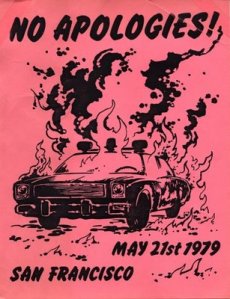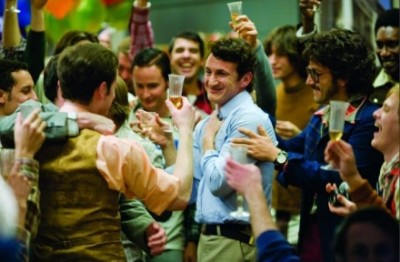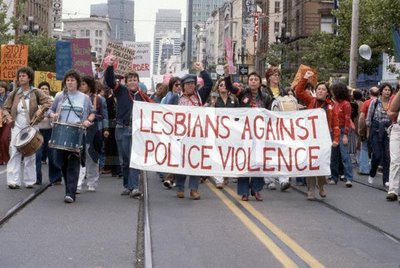Tags
activism, assassination, california, castro street, Constitution, democracy, Dianne feinstein, equal protection, film, film review, gay, george moscone, Harvey milk, history, jochild, lesbian, LGBTI, liberal, marriage equality, news, politics, populism, Privacy, progressive, rady ananda, same-sex marriage, san Francisco
 November 16, 2008
November 16, 2008
By Rady Ananda
Gay rights icon Harvey Milk is covered in numerous books and movies, including the Academy Award–winning 1984 documentary, “The Times of Harvey Milk.” His life is also the basis of a 2008 major motion picture, “Milk,” starring Academy Award winner Sean Penn and directed by Academy Award nominee Gus Van Sant. This collection of videos, photos and personal accounts provides background for the Nov. 26th release of “Milk.”
1979 flyer; hat tip to Maggie’s Meta Watershed blogspot. Flyer created and distributed by Lesbians Against Police Violence and The Stonewall Coalition [mixed-gender lesbian/gay organization allied with LAPV] in summer 1979 in the aftermath of the White Night Riots; likely drawn by Emily Siegel. – Maggie Jochild
Gay rights icon Harvey Milk (1930-1978) has been the subject of numerous books and movies, including the Academy Award–winning 1984 documentary, The Times of Harvey Milk. His life is also the basis of a 2008 major motion picture, Milk, starring Academy Award winner Sean Penn and directed by Academy Award nominee Gus Van Sant.
 Milk was the first openly gay man to be elected to public office in America. In 1977, he was voted to the city supervisors’ board of San Francisco. The following year, both he and the city’s mayor, George Moscone, were shot to death by another city supervisor, Dan White, who served a sum total of five years, one month and eight days for assassinating two people with whom he disagreed politically.
Milk was the first openly gay man to be elected to public office in America. In 1977, he was voted to the city supervisors’ board of San Francisco. The following year, both he and the city’s mayor, George Moscone, were shot to death by another city supervisor, Dan White, who served a sum total of five years, one month and eight days for assassinating two people with whom he disagreed politically.
Milk premiered on Thursday in Beverly Hills at The Academy of Motion Pictures Arts & Sciences, where a candlelight vigil ensued in remembrance of Harvey Milk and in grief over reported results that California passed Proposition 8, the same sex marriage ban. The film opens nationwide on Nov. 26th.
Milk is timely and highly relevant, given the ongoing assault on LGBT dignity with reported passage of laws designed to legitimize second-class status. The elections of 2004 and 2008 saw passage of discriminatory laws in over a dozen states. This increases Milk’s stature as an icon for equality for all. YouTube has a trailer.
The White Night Riots
After an eleven-day trial, on May 21, 1979, White was convicted of two counts of voluntary manslaughter. (Mainstream media misattributed the lesser conviction to the “Twinkie Defense” claiming diminished capacity from eating too much sugar, but attorney Doug Schmidt actually argued diminished capacity due to depression, although he did assert that White binged on junk food.) Once the verdict was announced, Gallo reports that:
“San Francisco erupted in violence; gay men and lesbians stormed City Hall, smashing its ornate front doors and setting police cars on fire. The San Francisco Police Department responded by invading … Castro, and brutalizing bystanders and bar patrons in reprisal for the ‘White Night’ riots.”
Some of that night is captured in this 45-second YouTube video:
It seems some of the above was pieced together from The Times of Harvey Milk, which uses several more minutes of video archive on the riots.
According to Wiki, “Both Milk’s election and the events following his assassination demonstrated the liberalization of the population and political conflicts between the city government and a conservative police force.” But any populist leader in the U.S. meets a similar fate, to wit: Paul Wellstone, John Lennon, JFK, RFK, MLK and Malcolm X, to name a few.

One organizer’s account, Maggie Jochild, formerly of Lesbians Against Police Violence (LAPV), clarifies some of the events leading up to the White Night Riot:
“LAPV stood in radical opposition to police harassment of minority communities. We saw Dan White’s assassination as a rage reprisal by a former cop against progressive forces (not just gay) and linked it to the larger picture of male and white domination. I think it’s critical to remember that the riot which came from our agitation was the result of revolutionary lesbians speaking out against the ultimate forces of power in our society, not a bunch of “gays” upset about a verdict.”
LAPV in parade after the 1979 White Night Riot
Another account, from straight white male, Chris Carlsson, corroborates that a “larger picture” was in motion:
“The riot had progressed, as San Francisco riots do, from the initial angry crowd (in this case, of gays) to a gradual influx of angry young black and brown men who are spoiling for a chance to even the odds with the cops. The amazing sense of community that had existed during the riot evaporated within 24 hours. Many of us were confused by the contrast: the riot’s euphoria temporarily intoxicated us with the sensation of true community. The aftermath returned us with a hard thud to a city full of barren crowds of disconnected people.”
Carlsson was apparently unaware of the long resistance to police brutality, or was unable to connect the shared common cause between the LGBT community and people of color, all of whom suffer brutal repression.
One analyst believes the picture was much bigger than this, even: “A nexus was forming in SF. Actual progressives and liberals were consolidating gains with actual political power.” He believes that because the assassinations took out the two most popular and most powerful forces for social liberalism, Dan White was probably guided by a wider concerted effort to crush San Francisco’s populist stronghold.
Jochild explains how LAPV wanted to use what it suspected would be a light verdict to publicize the issues:
“We knew public outrage was going to demand appeasement, and we knew we were the best target. We had been visibly agitating against the police for several months, one time holding a demonstration in front of Police Headquarters on 6th….
“We relentlessly argued that Dan White’s actions were the natural byproduct of his training as a cop. We said lesbians, gays, progressives, working people and people of color would always be targets of police repression as long as police existed; therefore, we advocated abolition of any legalized armed force in our society….
“We had called the rally at Castro Street that evening because we knew the jury’s verdict about Dan White would be in, and, guessing that justice would not be fully served, we wanted to capitalize on people’s anger for our own purposes. My roommate Sharon and I had made the signs announcing the rally and put them around the Mission and Castro Street.”
Of the many available accounts of that night, it seems that people spontaneously flocked to the Castro area as the natural place to share grief and outrage with like-minded folk. It’s also likely the Jochild and LAPV successfully contributed to encouraging the violent direction that night took; their outrage at the verdict was widely shared.
Conflicting reports leave a question about police action that night. Some say the police were told to stand down while people rioted for several hours, while others report widespread police brutality. Mainstream queers assert they tried to stop the violence, which was supposedly escalated by those outside the LGBT community. Another personal account, as written by Kim Corsaro, clarifies that police action was immediate:
“The crowd from the Castro was met with a large crowd from the Polk, which in the late 1970s was a thriving gay neighborhood and still the central location for a lot of gay celebrations, like Halloween. The mood quickly turned ugly as the crowds merged, and a pitched battle between the cops and the crowd began. The battle would last for the next several hours. Gay rioters started several small fires inside City Hall, smashed the windows, and torched dozens of police cars.”
Undisputed is that, later on in the evening, police stormed a local gay pub and bashed everyone inside and on the sidewalks outside the bar. Corsaro explains:
“The day after the riots, May 22, happened to be Milk’s birthday. That night in 1979, Castro Street filled again, this time to celebrate the first birthday date since his assassination. I was one of the unlucky riot-goers who had been brutally beaten by a handful of cops in Civic Center the night before, so I recovered at home. The screams I had heard coming from the Castro the night before when the cops raided the Elephant Walk were replaced by the sounds of ‘Happy Birthday, Harvey.'”
Just considering the numbers of those who required hospitalization, Wiki notes: “By morning, 61 police officers and 100 rioters and gay residents of the Castro had been hospitalized. Over a million dollars of damage had been done to City Hall, police cruisers, and the Elephant Walk Bar.”
It will be interesting to see how Milk covers the riot and police behavior during and afterward. Will it show the political divisions within the queer community?
Key accomplishments & Tributes
* Successfully implemented a boycott of Coors Beer in SF’s gay bars;
* Annually organized the Castro Street parade;
* First openly gay person to be elected to public office in the nation;
* Sponsored a civil rights bill that outlawed discrimination based on sexual orientation. The ordinance was called the “most stringent and encompassing in the nation”, and its passing demonstrated “the growing political power of homosexuals,” according to The New York Times, as reported in Wiki;
* Implemented the “District Election System” that allowed candidates for Supervisor to run from the District, rather than from the City at large – neighborhoods could thus run the city through representation, rather than rule by city elites;
* Proposed the successful “pooper scooper” law, garnering national attention;
* Compassionately, but unwisely, supported adoption of computerized voting so that San Francisco’s large Chinese population could use ballots in their own language.
Several organizations have formed which bear his name, including:
- The Harvey Milk Institute in San Francisco, California, with a mission of fostering the development and examination of lesbian, gay, bisexual, transgender and queer culture and community in the Bay Area and beyond.
- The SF Library Harvey Milk branch in Eureka;
- The Harvey Milk Civil Rights Academy; a small, public alternative elementary school located in the heart of the Castro District;
- The Harvey Milk High School in New York City. The Hetrick-Martin Institute believes all young people, regardless of sexual orientation or identity, deserve a safe and supportive environment in which to achieve their full potential.
- Harvey Milk Plaza – dedicated in 2006, the installation includes a series of Harvey Milk Photographic Tribute Plaques, which depict the arc of Milk’s life and political career and are made of photographs fused into porcelain enamel and are comprised of eleven images by some of the era’s photojournalists.
Gus Van Sant’s Milk should raise more awareness about the plight of the LGBT community. Meanwhile, Hulu has the complete The Times of Harvey Milk documentary, by Robert Epstein and Richard Schmiechen, with narration by Harvey Fierstein. Occasional commercials make free Hulu webcasts possible. (01:27:34) (Hat tip to James Nimmo.)
Unlinked Sources:
Marcia M. Gallo, Different Daughters: A history of the Daughters of Bilitis and the Rise of the Lesbian Rights Movement. New York: Carroll & Graf, 2006, pp 205-206.
Randy Shilts, The Mayor of Castro Street: The Life and Times of Harvey Milk. New York: St Martin’s Press, 1982, pp 349-352.
